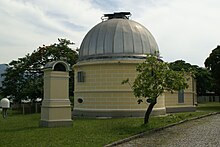National Observatory (Brazil)
 |
|
| Organization | Ministry of Science, Technology and Innovation |
|---|---|
| Location | Rio de Janeiro, RJ, Brazil |
| Coordinates | 22°53′43″S 43°13′29″W / 22.8953°S 43.2246°WCoordinates: 22°53′43″S 43°13′29″W / 22.8953°S 43.2246°W |
| Established | 1827 |
| Website | ON Website |
|
[]
|
|
The National Observatory (Portuguese: Observatório Nacional or ON)) is an institution localized in Rio de Janeiro, Brazil. Founded by Pedro I in October 15, 1827, it is one of the oldest scientific institutions in the country. Its initial purpose was to guide the geographic studies of Brazil and teaching navigation.
The institute is responsible for the Brazilian Official Time and performs various researches and studies in Astronomy, Astrophysics and Geophysics. It offers post-graduate courses leading masters and doctorate degree.
There has been astronomical observation in Brazil since the colonial times. According to Father Serafim Leite, the Jesuits installed an observatory in his school in Castle Hill in the Rio de Janeiro in 1730. In the same place, in 1780, Portuguese astronomers Sanches d'Orta and Oliveira Barbosa set up an observatory and began to perform regular observations of astronomy, meteorology and terrestrial magnetism. With the transfer of the Portuguese court to Brazil in 1808, the collection of this observatory was transferred to the Royal Military Academy.
On September 27, 1827, the General Assembly Legislative Empire, authorized the government to create an Astronomical Observatory under the Ministry of the Empire, and October 15, 1827, the Emperor D. Pedro I decreed its creation. He was installed in the tower of the Military School, and was directed initially at math professor Pedro de Alcântara Bellegarde. In 1845, the then Minister of War, Francisco Jeronimo Coelho, reorganized the institution as Imperial Observatory of Rio de Janeiro, when he assumed the position of Director, Professor Soulier Sauve, Military School, who moved to the fortress of Conception, and, in 1846, had its first Regulation approved by decree.
...
Wikipedia

